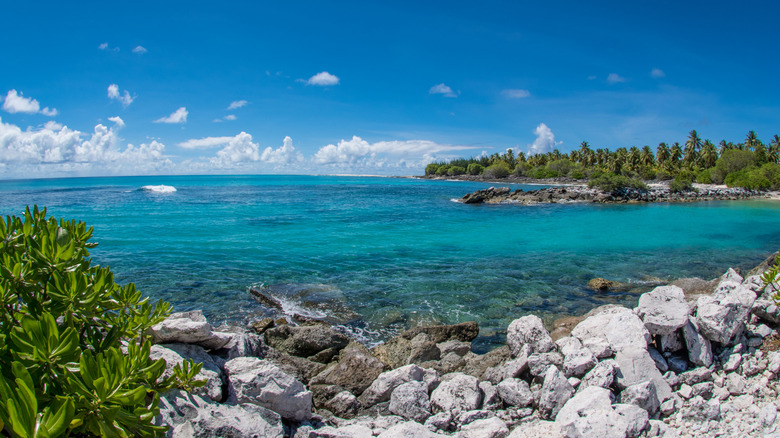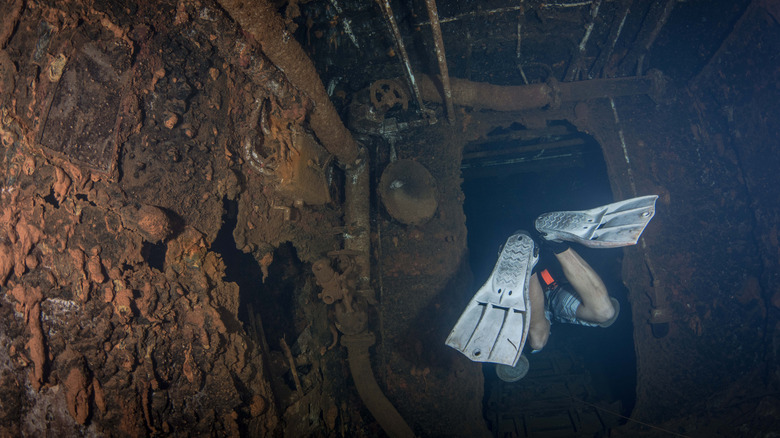A Dangerously Uninhabitable Pacific Island Is A Wreck-Diving Mecca And Thriving Shark Sanctuary
Bikini Atoll likely has the most misleading name in the history of islands — more than Mexico's Isla Mujeres or England's Isle of Man. Far from being full of Insta-posing beach models, Bikini Atoll is an uninhabited, radioactive no-man's-land northwest of the Marshall Islands that got flattened by 67 United States nuclear tests from 1946 to 1958. The atoll's 167 inhabitants were relocated for "the good of mankind and to end all world war" (per the National Museum of American History), starved and suffered along the way, while three of the atoll's islands — Bokonijien, Aerokojlol, and Namu — got completely vaporized. Now, sharks prowl its waters above a gallery of shattered and salt-eaten warships, barnacle-encrusted submarines, and the wreckage of the USS Saratoga. But for folks keen on diving to explore this "nuclear ghost fleet," few places could be as awesome.
On the surface, modern-day Bikini Atoll doesn't look too different from any other, idyllic, beach-lined Pacific island, or even a Hawaiian beach like the pristine Kawakiu Beach on Molokai. There are clear, turquoise waters, sandy coastal strips, and thriving greenery. There are also battered bunkers and abandoned buildings that tell the story of the atoll's pained past, a past that's made it a UNESCO World Heritage Site. But the atoll's real story lives beneath its waters amidst a graveyard of about 21 skeletal ship remnants. While the atoll has been reduced to a population of four to six caretakers, divers travel far and wide to visit its waters, wrecks, and marine life en masse. And while permanent residence is impossible because of the atoll's radiation, visiting is ok — within reason. Just stick to bottled water.
Bikini Atoll was the site of numerous nuclear tests
Because context is everything, it pays to dive into the tale of Bikini Atoll before considering diving into its waters. Come 1946 and after dropping the atomic bombs Little Boy and Fat Man on Hiroshima and Nagasaki, respectively, the United States set about its next phase of nuclear testing in the form of Operation Crossroads. Far from being an ultra-top secret research venture like J. Robert Oppenheimer's Manhattan Project, Operation Crossroads was an open, highly publicized and public show of U.S. might and military power. Planes dropped bomb after bomb after Bikini Atoll, chosen for its remote location, to test the effects of nuclear weaponry on warships. Five ships sank in the first test alone, and it burned the paint on vessels 11,100 feet away. This continued all the way until 1958. Every single ship that divers can visit at the bottom of the waters in the atoll comes from these tests, not from military battles.
But other battles did happen on the atoll related to its inhabitants. Commodore Ben H. Wyatt convinced Bikinian farmers and fishers to abandon their homes for the Kwajalein Atoll 200 miles away, a location that had gotten pulverized with bombs during World War II. Eventually, 160 Bikinians made it back to Bikini Atoll, where they suffered radiation poisoning, stillbirths, miscarriages, and more. They won a 1975 lawsuit against the U.S. government that still pays out to this day. And even though life has returned to Bikini Atoll's waters in the form of tuna, barracudas, sharks, manta rays, and more — all of which can be visited and are oblivious to the history above them — the Bikinians' perishable homes have long-since disintegrated.
A wreck diver's paradise awaits Bikini Atoll visitors
Nowadays, Bikini Atoll isn't only a wreck-diving mecca, but a prime "dark tourism" spot and the subject of an endless ream of mini-documentaries on YouTube that allow the rest of us the dive vicariously. Ship after ship of the atoll's ruined fleet — the USS Saratoga, Anderson, Arkansas, Lampson, etc. — rests at depths starting about 170 feet beneath the water's surface. You've got to be a certified technical diver to head down there, so traveling snorkelers on a picturesque island like Minicoy Island need not apply.
Would-be visitors can't even go to Bikini Atoll except via particular diving ships, although some of those ships are nice enough to essentially be mini-cruises. Master Liveaboards, in particular, offers cutting-edge diving facilities as well as package deals up to 13 days long for a whopping $8,710 per person. It should be noted that they recommend a 100-dive minimum before plunging into the atoll amidst its rusted and broken vessels. Their ships set out from the Kwajalein Atoll, which requires landing on a U.S. Army airfield and leaving immediately.
And while it's not likely that travelers to Bikini Atoll's wrecks are there for the wildlife, there's plenty to be found on the dive down. In addition to thriving coral reefs (which you should never mess with while snorkeling or diving), numerous species of sharks have taken to calling the atoll home: hammerheads, blacktip, white tip, gray reef, Indo-Pacific lemon, Galapagos sharks, and others. But no worries, because humans aren't sharks' favorite prey. Divers should be far more worried about decompression sickness and radiation. But if you don't touch the wreckages, you should at least be somewhat safe from the latter.


